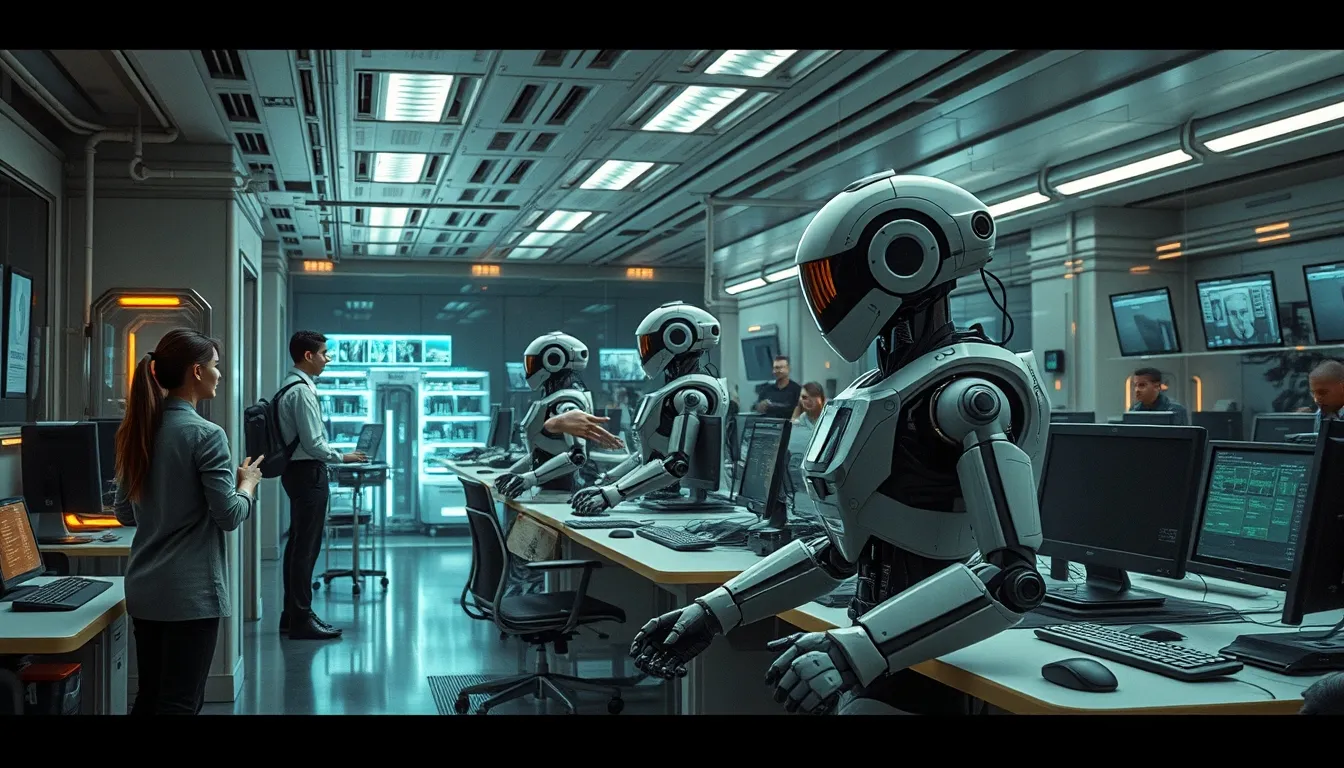Workforce transformation has become a strategic necessity as companies strive to align their workforce with evolving demands in today’s rapidly changing business landscape. HR leaders are at the forefront, guiding their teams through this complex transition to ensure employees are equipped with the skills and adaptability needed to thrive in a future defined by artificial intelligence and automation. With examples like Unilever leading the way, successful transformation is built on continuous learning, strategic talent acquisition, and a commitment to diversity and inclusion.
The imperative of workforce transformation in modern business

In today’s fast-paced global economy, human resources professionals face unprecedented challenges that demand constant adaptation.Technological advancements like artificial intelligence and automation are driving the need for workforce transformation. HR leaders must guide their organizations in rethinking strategies to stay relevant amidst these innovations and shifting market demands.
Workforce transformation is crucial in reshaping business models and aligning workforce strategies with overarching organizational goals. By doing so, companies can maintain their competitive edge and adapt swiftly to changing circumstances. Businesses that fail to integrate these technologies risk falling behind, as market shifts demand agility in workforce planning to ensure employees possess the skills necessary to meet new challenges head-on.
For HR professionals, aligning workforce strategies with organizational goals is vital. It ensures that the workforce is equipped to drive innovation and achieve business objectives. HR can foster a culture of continuous improvement, keeping the organization agile and responsive to change.
Decoding workforce transformation: more than just a buzzword

While workforce transformation is often associated with technological upgrades, it encompasses much more. It involves a comprehensive approach that aligns employee skills with the organization’s evolving needs. This process reimagines roles and fosters a culture of continuous adaptation, ultimately driving innovation and strategic alignment.
At its core, workforce transformation is about creating an environment where employees feel engaged and empowered. It encourages learning, development, and the reimagining of traditional roles to better fit the evolving landscape. This holistic approach ensures that workforce transformation is not just a trend but a strategic necessity.
The benefits of workforce transformation are numerous. It drives innovation by encouraging employees to think creatively and adapt to new challenges. It also enhances employee engagement by providing opportunities for growth and development, leading to greater alignment with organizational goals.
Catalysts of change: what’s driving workforce transformation?
The tech revolution

The tech revolution is at the forefront of workforce transformation. With the advent of artificial intelligence, machine learning, and automation, work processes are undergoing a fundamental shift. These technologies are redefining how work gets done, and organizations must adapt to these technological shifts to avoid obsolescence.
This requires reimagining roles, upskilling employees, and integrating technology into everyday processes. By doing so, companies can harness the power of these technologies to enhance productivity and innovation.
Global market dynamics
Beyond technology, global market dynamics play a crucial role in shaping workforce transformation. As businesses expand globally, the need for a workforce with cross-cultural competence becomes increasingly important. Organizations must navigate diverse markets and cultural landscapes with agility and adaptability.
Cross-cultural competence is invaluable in today’s interconnected world. It enables organizations to understand and respond to diverse customer needs, fostering stronger relationships and driving business success. Adaptability is key to thriving in this dynamic environment, allowing organizations to pivot and seize new opportunities as they arise.
The evolving employee
Today’s workforce seeks more than just a paycheck. Employees demand growth opportunities, work-life balance, and a sense of purpose in their roles. Organizations must evolve to meet these changing expectations to attract and retain top talent.
By providing growth opportunities and fostering a sense of purpose, HR professionals can create a more engaged and motivated workforce. This not only enhances employee satisfaction but also drives business success by aligning individual goals with organizational objectives.
Navigating the transformation: key strategies for success
Embracing a learning culture
In the modern business environment, continuous learning is crucial. Organizations must invest in upskilling and reskilling initiatives to ensure their workforce remains relevant and agile. Fostering a learning culture encourages employees to stay updated with the latest industry trends and technologies, benefiting both individual employees and the organization as a whole.
Strategic talent acquisition
The evolution of hiring practices is essential for identifying individuals with future-ready skills. Traditional qualifications are no longer the sole criteria; organizations must assess adaptability and potential when selecting candidates.
By focusing on strategic talent acquisition, companies can build a workforce prepared to tackle future challenges. This involves looking beyond conventional markers of success and identifying individuals who can thrive in a rapidly changing environment.
Fostering diversity and inclusion
A diverse workforce brings varied perspectives, fostering innovation and creativity. Organizations must create an inclusive environment where all employees feel valued and heard.
By prioritizing diversity and inclusion, companies can harness the full potential of their workforce. This not only enhances creativity and innovation but also strengthens the organization’s reputation and appeal to a broader range of stakeholders.
Harnessing technology for HR
Leveraging human capital management systems and engagement platforms can streamline processes and enhance the employee experience. By using technology effectively, organizations can make their transformation efforts more efficient and impactful. Technology can automate administrative tasks, provide valuable insights, and enhance communication, enabling HR teams to focus on strategic initiatives that drive workforce transformation.
Mastering change management
For HR professionals, successful transformation requires buy-in at all levels of the organization. Clear communication of the vision and ongoing support are crucial for ensuring effective change management. HR plays a key role in facilitating this process.
How can organizations ensure effective change management?
To ensure effective change management, organizations should focus on building a coalition of support throughout the change process. This involves engaging stakeholders at all levels, addressing concerns, and providing the necessary resources and training to facilitate a smooth transition.
Clear communication of the vision and benefits of transformation is essential. By aligning the change initiative with organizational goals and demonstrating its value, organizations can secure buy-in and drive successful transformation efforts.
Overcoming hurdles: common challenges in workforce transformation
Securing organizational buy-in
Convincing leadership of the value of transformation can be challenging. It’s crucial to demonstrate the tangible benefits and long-term return on investment (ROI) of these initiatives. Organizations can overcome this hurdle by presenting a compelling business case that highlights the strategic advantages of workforce transformation. By showcasing success stories and data-driven insights, companies can build a strong case for change.
Managing a dispersed workforce
With remote work becoming more prevalent, organizations must adapt their management strategies to effectively engage and support a distributed team. Successful management of a dispersed workforce requires clear communication, the use of collaboration tools, and a focus on maintaining team cohesion. By providing support and resources for remote employees, organizations can ensure productivity and engagement.
Maintaining strategic alignment
Transformation efforts must align with the organization’s overall vision and goals. Failing to maintain this alignment can lead to wasted resources and missed opportunities.
What are the risks of misalignment in workforce transformation?
The risks of misalignment include inefficient resource allocation, decreased employee morale, and the potential for strategic initiatives to fall short of expectations. Misalignment can also hinder the organization’s ability to respond to market changes effectively.
To mitigate these risks, organizations should regularly review and adjust their transformation strategies to ensure they align with evolving business priorities.
Learning from the best: Unilever’s transformation journey
Despite the challenges, companies like Unilever demonstrate how successful workforce transformation can be achieved. Unilever exemplifies successful workforce transformation through its innovative approach. The company has focused on continuous learning, personalized career paths, and an internal talent marketplace to maintain its competitive edge in a rapidly changing market.
By prioritizing employee development and aligning workforce strategies with business objectives, Unilever has created a resilient and adaptable organization. This approach serves as a valuable model for other companies seeking to navigate the complexities of workforce transformation effectively.
Charting the course for future success
Workforce transformation is not a one-time event but an ongoing process. Organizations that embrace this reality and invest in their people will be best positioned to thrive in an evolving business landscape. By focusing on continuous learning, strategic hiring, diversity and inclusion, technology adoption, and effective change management, companies can build a resilient and agile workforce ready to meet the challenges of tomorrow.
In this ever-changing world, HR professionals must master workforce transformation to ensure long-term success. By staying adaptable and committed to fostering a forward-thinking workforce, organizations can ensure their continued growth and prosperity. Finally, aligning workforce transformation with organizational goals remains a cornerstone for achieving sustainable success, with HR at the forefront of these efforts.


